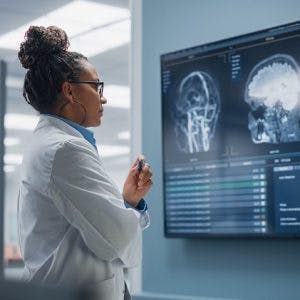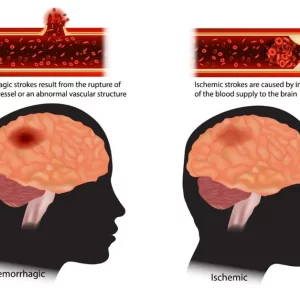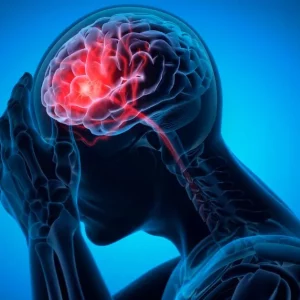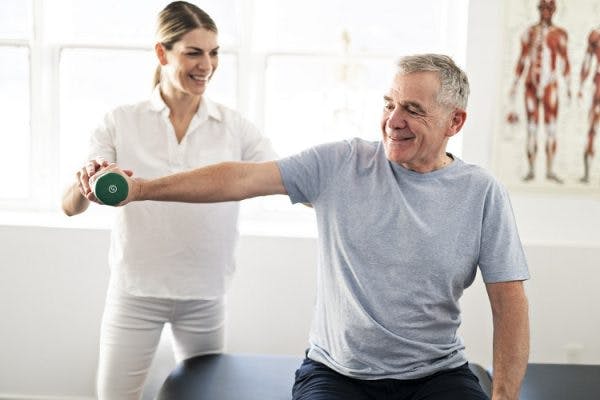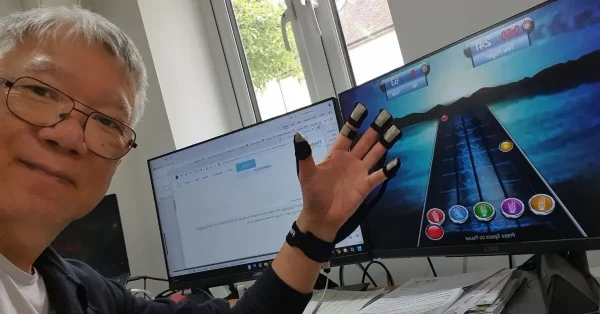Middle cerebral artery stroke, called MCA stroke, is a neurological injury that can result in a variety of secondary effects, altering daily life for many survivors. Fortunately, there is hope for recovery through consistency, dedication, and commitment to an intentional rehabilitation program.
In this article we will discuss the causes of MCA stroke, common symptoms, and treatment to get you back to the activities you love. Feel free to use these links to help you navigate through this article:
What Causes MCA Stroke?
MCA stroke occurs when blood flow through the middle cerebral artery in the brain is interrupted. This can be due to ischemia, where blood flow is partially restricted, or infarct, where blood flow is restricted completely. Additionally, a stroke can be hemorrhagic, meaning the stroke was caused due to aneurysm or rupture of the artery. This leads to uncontrolled bleeding in the brain and can create an increase in pressure.
Most MCA stroke cases occur due to ischemia, which prevents the brain from getting sufficient oxygen and nutrients. This causes damage as brain cells begin to die and is why fast action is vital if someone begins to exhibit stroke symptoms. The faster medical care is administered, the more this damage can be contained and secondary effects can be minimized.
The middle cerebral artery branches off the carotid artery and is the most commonly-affected artery in acute stroke cases. Due to its importance for supplying blood flow to the brain, damage to the MCA can result in a wide variety of impairments. For example, the MCA supplies blood to major areas of the brain such as the primary motor cortex and somatosensory cortex, as well as deeper structures.
Furthermore, MCA stroke can be divided into two sub-categories, left and right. This refers to the side of the brain most affected by the loss of blood flow to the brain via the middle cerebral artery. Depending on which area of the MCA is specifically affected, either hemisphere can be damaged and lead to a wide variety of deficits.
Left MCA Stroke
The two hemispheres (halves) of the brain are each responsible for controlling the opposite side of the body. A left MCA stroke refers to a stroke that has resulted primarily in damage to the left hemisphere. This results in secondary effects present on the right side of the body, such as right hemiplegia (paralysis on the right side of the body) or right hemiparesis (weakness on the right side of the body). We will review other potential effects later in this article.
Right MCA Stroke
This type of stroke occurs following damage to the right distribution of the middle cerebral artery. The resulting damage to the brain’s right hemisphere causes deficits to be present primarily on the left side of the body, such as left hemiplegia or left hemiparesis.
Right MCA strokes occur less frequently than left MCA strokes but can be more difficult to recognize or differentiate due to unclear symptoms. Although right MCA strokes occur less frequently, this does not necessarily mean they are less severe.
Symptoms of MCA Stroke
Due to its extensive role in providing blood flow to the brain, damage to the middle cerebral artery can result in many different symptoms and secondary effects. This depends heavily on the area(s) of the brain affected as well as the severity of the stroke. To help you understand the differentiation of symptoms, we will discuss the different secondary effects of MCA stroke based on the hemispheres affected.
Common symptoms and secondary effects of left MCA stroke include:
- Motor Apraxia: Difficulty planning and carrying out movements
- Aphasia: Difficulty comprehending language, forming words, or building complex sentences
- Numbness or weakness on the right side of the body
- Increased frustration
- Impaired swallowing ability
- Cautious behavior
- Memory impairment
Common symptoms and secondary effects of right MCA stroke include:
- Left side paralysis
- Facial weakness
- Reckless behavior or poor decision making
- Left neglect
- Visuospatial deficits
- Memory impairment
Although MCA strokes are sometimes divided into left and right, this classification is not always clear in every stroke case. Some individuals experience damage to both hemispheres following MCA ischemia, leading to a combination of symptoms.
Diagnosis and Initial Treatment
When an individual reaches the hospital with suspected stroke symptoms, the initial focus of treatment is containing the stroke and minimizing damage to the brain. To help resolve ischemia, the individual may be given a medication called tissue plasminogen activator, or tPA. TPA is primarily used to break up a clot and help restore blood flow to the brain, although it must be administered within 3-4.5 hours after symptom onset.
Diagnosis of an MCA stroke generally occurs using imaging such as CT or MRI to help pinpoint the area of the brain affected. Imaging is commonly performed within the first hour after an individual is admitted to the hospital as this allows medical staff to appropriately provide the necessary treatments.
Although some strokes can be managed with medication, some require surgical intervention to remove a clot or decrease pressure on the brain. This depends on the type and severity of the stroke and can include procedures such as a mechanical embolectomy (sometimes called a thrombectomy) or a craniotomy.
Rehabilitation for Stroke in the Middle Cerebral Artery
The secondary effects of MCA stroke vary widely depending on the areas of the brain affected. These secondary effects can include motor, somatosensory, cognitive, and emotional impairments. However, there is always hope for survivors of MCA stroke to regain function and improve quality of life through a comprehensive rehabilitation program.
After injury to the brain, the nervous system can heal and restore function through a process called neuroplasticity. Utilizing neuroplasticity, areas of the brain that did not sustain damage are able to create new connections and neural pathways, compensating for a loss in function after MCA stroke.
Following MCA stroke, rehabilitation can consist of many treatments and therapies to help regain lost function. This can include physical, occupational, speech, and cognitive therapy to help address and improve all aspects of daily life. Following MCA stroke, the main goals of rehabilitation will include:
- Restoring physical function
- Maximizing independence and activities of daily living (ADLs)
- Enhancing cognitive and emotional function
Restoring Physical Function
One major goal for survivors of MCA stroke is regaining lost physical function. This will be the focus of physical and occupational therapy to enhance performance of daily activities. In addition to in-person sessions, your therapy team will provide you with exercises for you to perform on your own to help you maximize your recovery.
A physical therapist will help you practice exercises focusing on range of motion, muscle strength, transfers (moving from one surface to another), and walking. An occupational therapist can help you relearn necessary activities of daily living, such as grooming or dressing, as well as work on gaining function of the hand and arm.
Maximizing Independence
Following MCA stroke, many survivors may feel they have lost some of their independence. Fortunately, physical, occupational, and speech therapists are trained to help you regain your independence with physical functions and motor skills.
For example, occupational therapists can recommend appropriate adaptive equipment to help you be as safe and independent as possible in your home environment. Speech therapists will help you work on swallow and speech skills to allow you to eat safely and communicate with others, increasing your freedom at home and in the community.
Lastly, physical therapists can help you move independently by working with you to increase your balance and overall mobility. In addition to walking, they can help you improve your ability to get in and out of bed, stand up from a chair, and help you create a plan to get regular exercise after MCA stroke.
Enhancing Cognitive Processing & Emotional Regulation
In addition to physical deficits, MCA stroke can lead to changes in emotional regulation and decreased cognitive function. As part of your rehabilitation plan, occupational and speech therapists can help you work on drills and exercises to allow you to develop critical-thinking skills and enhance cognitive processing. This may include cognitive exercises such as brain teasers, word games, and multi-tasking activities performed alongside a physical exercise.
As a complement to your speech therapy, the CT Speech & Cognitive Therapy App offers over 100,000 scientifically-based speech exercises that individuals can practice independently. It can also assesses individual skill level to provide appropriately challenging exercises, automatically adjusting the difficulty of exercises as you improve so that you are appropriately challenged each time you sign in.
Want to learn more about the CT Speech and Cognitive Therapy App? Get Started Here.
(Link opens a pop-up for uninterrupted reading.)
Many survivors also experience behavioral and emotional changes after MCA stroke. This is where a cognitive-behavioral therapist can be of assistance. These are trained health experts who can help you pinpoint negative behaviors or thought patterns and develop strategies to overcome them. They can also help you learn new strategies to cope with life changes and work through feelings of grief or sadness that you may experience after MCA stroke.
Depression is a commonly experienced condition following stroke, affecting as many as 1/3 of stroke survivors. It is important to talk with your provider if you are experiencing symptoms of depression to develop a treatment plan and get connected with helpful resources.
Summary
MCA stroke can affect either hemisphere of the brain, resulting in a wide variety of symptoms depending on the areas affected. Left MCA stroke affects the left hemisphere of the brain and causes deficits on the right side of the body. Contrarily, right MCA stroke affects the right side of the brain and often results in left-sided paralysis or neglect, impulsive behavior, and facial weakness.
Identifying the areas of the brain affected and resulting deficits can allow your rehab team to create a comprehensive plan to help you reach your goals and regain independence.
We hope this article has helped you better understand the symptoms of MCA stroke as well as encourage you to pursue rehabilitation. All stroke survivors can achieve improvement in function through neuroplasticity and consistent, dedicated practice.



